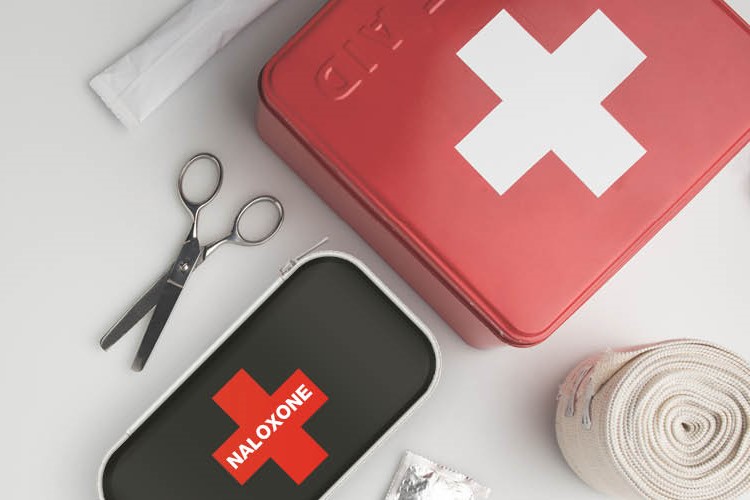The opioid crisis in Canada continues to be one of the biggest public health issues facing our nation. Unfortunately, the situation may be getting worse. There is emerging evidence that the COVID-19 pandemic exacerbated the opioid crisis in Ontario.1 Data from the Public Health of Ontario and a report from the Ontario COVID-19 Science Advisory Table indicates that since March 2020, the rate of opioid overdoses caused by opioid toxicity have risen sharply.2,3
As frontline health care professionals, pharmacists have an important role to play in combatting the opioid crisis. Pharmacist-led harm reduction interventions such as naloxone dispensing and counselling remain important solutions in addressing this public health concern. The following article is intended to enable pharmacists to confidently incorporate naloxone dispensing in their practice by providing an overview on naloxone therapeutics, summarizing updates on the Canadian National Consensus Guidelines for Naloxone Prescribing, and discussing practical tips for initiating conversations about naloxone with patients.
Canadian National Consensus Guidelines for Naloxone Prescribing by Pharmacists: Who Should Receive Naloxone?
Pharmacists may encounter difficulties when assessing a patient’s risk for opioid poisoning. Certain stigmas and biases around opioid use and the fear of judgement may inhibit patients from being forthcoming about relevant pieces of information. On the other hand, using objective measures, such as the patient’s medication profile, to conduct a risk assessment is complicated by the fact that some patients may fill prescriptions at more than one pharmacy. In either scenario, the pharmacist is left with an incomplete picture regarding the patient’s true risk.
Furthermore, data indicates that the risk of an opioid poisoning when using prescription opioids may be underestimated by both patients and health care professionals. According to a report, in 2016, 80% of people visiting an emergency department for an opioid toxicity event had received a prescription opioid in the previous three years. This is a harrowing statistic given that a review of ONPP uptake found only 1.6% of patients prescribed opioids also received a take-home naloxone kit.4,5
Given these challenges and significant burden of the opioid crisis, a 2020 peer-reviewed paper published in the Canadian Pharmacists Journal aimed at establishing guidelines and recommendations on pharmacists use and distribution of naloxone. The most recent guidelines on naloxone dispensing recommend that pharmacists provide take-home naloxone kits to all patients receiving an opioid medication and provide counselling on naloxone use.6 The guidelines also stress the importance of creating a follow-up plan for patients receiving opioids, and currently recommends that pharmacists follow up with patients three months and one year after the initial consultation.6 Follow-up conversations provide pharmacists with the opportunity to refresh the patient’s knowledge of naloxone use in emergencies, monitor for any changes to a patient’s medical history that may increase their risk of an opioid poisoning, and ensure the patient is not in possession of expired naloxone.

As accessible and trusted health care professionals, pharmacists are in a unique position to address the opioid public health crisis. By routinely co-dispensing naloxone with opioids, pharmacists can proactively protect patients and individuals in their communities from the severe consequences of an opioid poisoning.
Barriers to Naloxone Distribution
Not all patients will initially be receptive to receiving naloxone due to perceived stigma and biases surrounding opioid use and overdose. Interviews with patients by the Ontario Drug Policy Research Network found that privacy concerns and fear of judgement from other patients and pharmacy staff are significant barriers to patients accessing naloxone from pharmacies.7
To successfully facilitate conversations around naloxone pharmacists may need to proactively address this concern. By routinely incorporating naloxone dispensing into your practice, and using neutral language that reduces stigma, pharmacists can normalize conversations around naloxone and help to create an inviting environment for their patients. Patients with privacy concerns can be made aware that a health card is not required to receive take-home naloxone kits.
To assist pharmacy professionals in navigating these conversations, the Ontario Pharmacists Association have developed a resource outlining how to initiate a conversation with patients about naloxone. This tool guides pharmacists through three possible patient reactions: receptive, hesitant, and unreceptive along with answers to frequent patient concerns. For patients who are hesitant or unreceptive, OPA has produced a patient handout containing valuable information about naloxone and opioid toxicity which may help lead to discussions in the future.

Naloxone Coverage in Ontario
Fortunately, cost is no longer a barrier to receiving naloxone in Ontario. With the implementation of the Ontario Naloxone Pharmacy Program (ONPP), pharmacies can dispense both intranasal naloxone spray (NARCAN® Nasal Spray) and injectable naloxone emergency kits at no cost to eligible patients. Importantly, patients do not require a prescription or health card to receive a publicly funded take-home naloxone kit in Ontario.
The following individuals are eligible for a naloxone kit through the ONPP:
- Individuals who are currently using opioids
- Individuals at risk of returning to opioid use
- Family members, friends, or others in a position to assist a person at risk of opioid poisoning
There is a maximum daily limit to how many naloxone kits can be dispensed to an eligible individual. Through the Ontario Naloxone Program for Pharmacies (ONPP), eligible individuals may receive up to two (2) naloxone kits at a time. Since the ONPP is meant to distribute naloxone on an individual basis, organizations would not be eligible to receive publicly funded naloxone. However, interested organizations can still obtain naloxone by purchasing it from their pharmacy.
The opioid crisis remains an ongoing and well-documented issue facing Canadians. With recent guidelines suggesting that pharmacists co-dispense naloxone with all opioid prescriptions, pharmacists are in a unique position to normalize naloxone. By incorporating this harm reduction strategy in their practice, pharmacists can empower individuals in their communities to effectively respond to opioid poisonings.
An Effective Antagonist
Naloxone is an opioid antagonist medication used to rapidly reverse opioid poisoning. Due to its high affinity for opioid receptors, naloxone displaces other competing opioids at the receptor sites through a process known as competitive inhibition. Through this displacement, naloxone temporarily counteracts the effects of opioids on the central nervous system (CNS) and respiratory systems. Importantly, naloxone is a non-addictive drug with no pharmacological effect in the absence of opioids. 8
In Canada, naloxone take-home kits are available through publicly funded programs in two different formulations, a nasal spray and intramuscular injection. 9
- Intranasal naloxone (NARCAN® Nasal Spray): NARCAN® Nasal Spray is a pure opioid antagonist indicated for emergency use to reverse known or suspected opioid overdose, as manifested by respiratory and/or severe central nervous system depression. NARCAN® Nasal Spray is administered directly into the nose, where it is absorbed and is administered in alternate nostrils with each dose.10 It has an onset of action of 2 to 3 minutes.9
- Intramuscular naloxone injection: The injections are administered into accessible intramuscular sites such as the vastus lateralis muscle (located at the middle outer thigh) or It has an onset of action of 3 to 5 minutes.9
Regardless of which naloxone kit is dispensed, patients should be counselled to administer naloxone as quickly as possible to individuals showing signs of an opioid poisoning. When dispensing NARCAN® Nasal Spray, the pharmacist should also instruct the patient or caregiver to read the PATIENT MEDICATION INFORMATION and the Quick Start Guide at the time they obtain NARCAN® Nasal Spray and to become familiar with administration procedures.10 Patients should be advised that signs of an opioid overdose include pinpoint pupils, slow or absent breathing, cold and clammy skin, blue lips and/or nails, unresponsiveness or unusual sleepiness, slow heartbeat or signs of low blood pressure.11
Following administration, both the nasal and injectable formulations of naloxone can be re-administered if the affected individual is not improving. The effects of naloxone wear off after 30 to 90 minutes, meaning that it only temporarily reverses the symptoms of an opioid poisoning.12 Naloxone is not a substitute for emergency medical care. Emergency medical assistance should be requested immediately when an opioid overdose is suspected, before administering naloxone. Since the duration of most opioids exceeds that of naloxone, and the suspected opioid overdose may occur outside of a supervised medical setting, the patient should be kept under continued surveillance until emergency personnel arrive.10

Safety information
Indications and clinical use10:
- NARCAN® NASAL SPRAY is a pure opioid antagonist indicated for emergency use to reverse known or suspected opioid overdose, as manifested by respiratory and/or severe central nervous system depression.
- NARCAN® NASAL SPRAY can be administered by a bystander (non-health care professional) before emergency medical assistance becomes available, but it is not intended to be a substitute for professional medical care. Emergency medical assistance (calling 911) should be requested immediately when an opioid overdose is suspected, before administering naloxone.
For more information
Please consult the product monograph at http://narcannasalspray.ca/pdf/NARCAN%C2%AE-Nasal-Spray-product-monograph-Mar%2005-2021-red-plunger.pdf for important information relating to contraindications, adverse reactions, drug interactions, patient selection and dosing information.
The product monograph is also available by calling 1-844-898-0657. Always direct patients to read and follow the directions on the label.
PP-NAR4-CA-00146-01-2023
The content for this article was created by OPA and sponsored by Emergent BioSolutions Canada Inc.

References
- Health Canada. Opioid and Stimulant-Related Harms in Canada.https://health-infobase.canada.ca/substance-related-harms/opioids-stimulants. Accessed on December 9th, 2022.
- Public Health Ontario. Opioids and Opioid Mortality. https://www.publichealthontario.ca/en/data-and-analysis/substance-use/opioid-mortality. Accessed December 9th, 2022.
- Friesen EL, Kurdyak PA, Gomes T, et al. The impact of the COVID-19 pandemic on opioid-related harm in Ontario. Science Briefs of the Ontario COVID-19 Science Advisory Table. 2021;2(42). https://doi.org/10.47326/ocsat.2021.02.42.1.0
- Choremis B, Campbell T, Tadrous M, Martins D, Antoniou T, Gomes T. The uptake of the pharmacy-dispensed naloxone kit program in Ontario: A population-based study. PLoS One. 2019;14(10):e0223589. Published 2019 Oct 18. doi:10.1371/journal.pone.0223589
- Gomes T, Khuu W, Martins D, Tadrous M, Mamdani MM, Paterson JM, et al. Contributions of prescribed and non-prescribed opioids to opioid related deaths: population-based cohort study in Ontario, Canada. BMJ. 2018;362:k3207.
- Tsuyuki RT, Arora V, Barnes M, et al. Canadian national consensus guidelines for naloxone prescribing by pharmacists. Can Pharm J (Ott). 2020;153(6):347-351. Published 2020 Aug 26. doi:10.1177/1715163520949973
- Antoniou, T., Pritlove, C., Shearer D., Martins, D., Tadrous, M., Munro, C., & Gomes, T. (2020). A qualitative study of a publicly funded pharmacy-dispensed naloxone program. International Journal of Drug Policy
- Jordan MR, Morrisonponce D. Naloxone. In: StatPearls. Treasure Island (FL): StatPearls Publishing; July 11, 2022. Accessed from: https://www.ncbi.nlm.nih.gov/books/NBK441910/
- Government of Canada. Naloxone. https://www.canada.ca/en/health-canada/services/opioids/naloxone.html. Accessed December 9th, 2022.
- Emergent BioSolutions Canada Ltd. NARCAN NASAL SPRAY Product Monograph. [updated March 5, 2021]. Available at: https://narcannasalspray.ca/pdf/NARCAN%C2%AE-Nasal-Spray-product-monograph-Mar%2005-2021-red-plunger.pdf
- Schiller EY, Goyal A, Mechanic OJ. Opioid Overdose. 2022 Sep 19. In: StatPearls [Internet]. Treasure Island (FL): StatPearls Publishing; 2022 Jan–. PMID: 29262202. Accessed from: https://www.ncbi.nlm.nih.gov/books/NBK470415/
- Naloxone DrugFacts. National Institute on Drug Abuse website. https://nida.nih.gov/publications/drugfacts/naloxone. Accessed December 9th, 2022.


